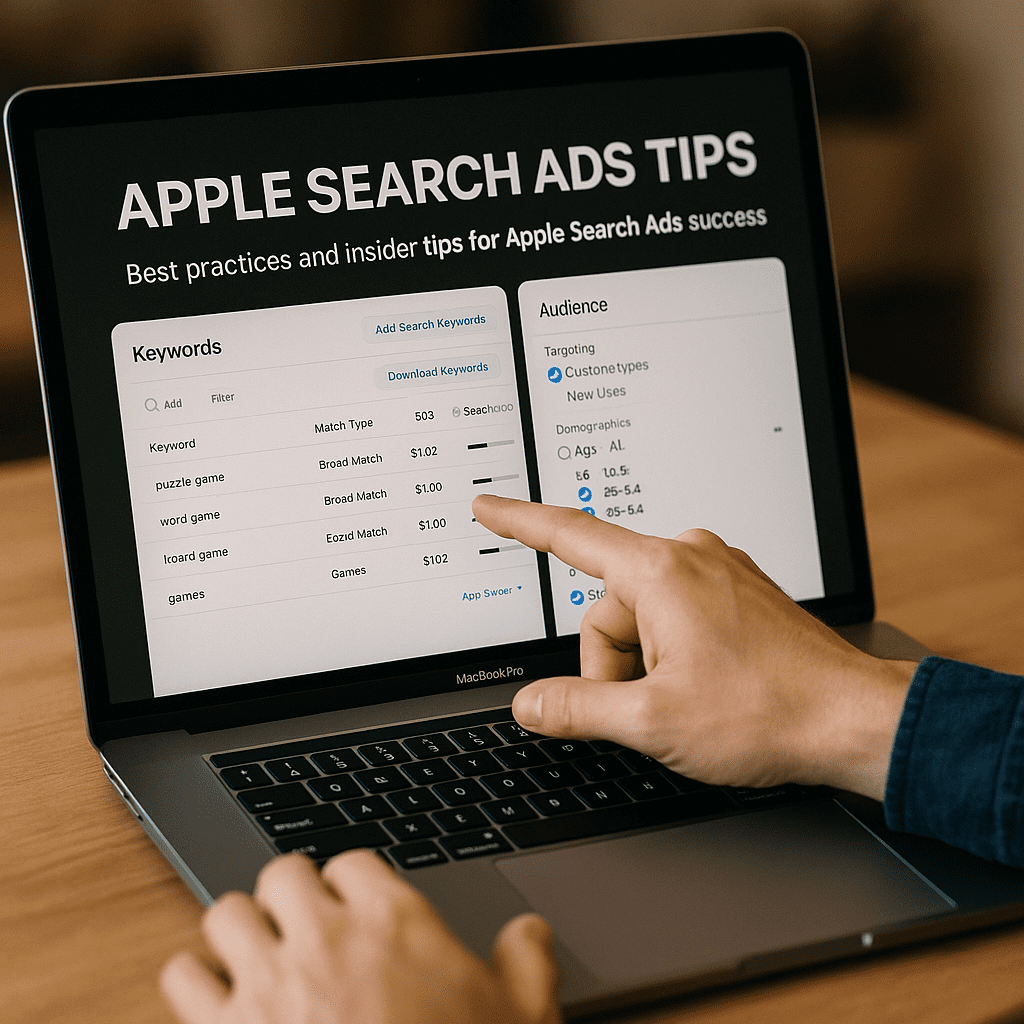
Apple Search Ads in 2025: Ultimate Guide to Best Practices and Insider Tips
Meta description: Discover a comprehensive blueprint for mastering Apple Search Ads in 2025. Learn proven campaign structures, keyword tactics, bid formulas, measurement strategies, and insider tips to boost visibility, installs, and ROAS across global markets.
In the ever-crowded App Store, high-intent traffic is gold. Apple Search Ads (ASA) delivers users with purchase and install intent directly at the moment of search. In 2025, ASA remains the single most effective paid channel for iOS user acquisition—accounting for over 60% of paid installs on iOS—if managed correctly.
This guide, written from the perspective of a CMO at a leading app growth agency, walks mobile app marketers and performance teams through the end-to-end process of planning, executing, and optimizing ASA campaigns. You’ll gain actionable insights on campaign structure, keyword strategy, bidding models, measurement best practices, and emerging trends.
1. Apple Search Ads Fundamentals
Apple Search Ads connects your app to users actively searching in the App Store. There are four placements available under ASA Advanced:
- Search Results: Appears at the very top of relevant search results, driving high click-through rates (CTR).
- Search Tab: Featured banner in the Search tab, offering broad exposure.
- Today Tab: Native-style ad cards in the Today feed, ideal for storytelling.
- Product Page: Shown on competitor or related app pages, capturing comparison shoppers.
Each placement addresses a different stage of the user journey—from discovery to decision—allowing you to tailor creatives and bids accordingly.
2. Effective Campaign Structure
Well-organized campaigns are the backbone of scalable ASA management. A clear hierarchy simplifies reporting, bid optimization, and budget allocation.
2.1 The Four-Campaign Framework
- Brand Campaign: Protect and monetize your own app name, variations, and misspellings. These keywords typically have the highest conversion rates (CVR 50–70%).
- Category Campaign: Target top-of-funnel, category-level terms (e.g., “photo editor,” “budget tracker”). Focus on high-search-volume keywords with moderate cost per tap (CPT).
- Competitor Campaign: Bid on competitor app names and branded terms. Price per tap may be 20–30% higher, but CVR often exceeds 30%. Use it sparingly.
- Discovery Campaign: Employ Search Match and broad match to uncover new keywords and long-tail opportunities. Allocate 10–15% of your budget here.
This segmentation prevents overlap and maximizes efficiency by aligning bids and budgets with intent and performance.
2.2 Geographic Segmentation
Performance and lifetime value (LTV) vary dramatically by region. Benchmarks show cost per install (CPI) can be three times higher in Tier 1 markets compared to Tier 3.
- Tier 1 Campaigns: US, UK, Canada, Australia. Set aggressive bids and dedicated budgets.
- Tier 2 Clusters: Western Europe, Japan, South Korea. Group by similar LTV to simplify management.
- Emerging Markets: Latin America, Southeast Asia, Eastern Europe. Allocate modest budgets and test localized creatives.
Adjust bids based on country-specific return on ad spend (ROAS) and tailor ad copy and screenshots for local preferences.
3. Keyword Strategy Optimization
Keywords are the primary targeting lever in ASA Advanced. With limited demographic signals, your keyword lists determine both reach and efficiency.
3.1 Match Types and Use Cases
- Exact Match: Highest precision. Reserve for top-performing brand and category terms.
- Broad Match: Expands to synonyms and related phrases. Best for discovery campaigns.
- Search Match: Automated keyword discovery based on metadata and performance signals. Use in parallel with manual match types.
Start new campaigns with a mix of all three, then allocate budget based on observed CPT and CVR.
3.2 Negative Keywords
Adding negative keywords prevents your ads from showing on irrelevant or low-value searches:
- Exclude generic or support-related terms (e.g., “app support,” “app review”).
- Block terms already in higher-priority campaigns (brand/category) to avoid bid cannibalization.
- Review search terms weekly to prune low-value traffic and discover new negatives.
4. Bid Management and Budgeting
Effective bidding balances visibility with cost control. Apple provides tools like Bid Suggestions and Bid Strength indicators—leverage them alongside your own formulas.
4.1 Bid Calculation Formula
Optimal Bid = Target CPA × Conversion Rate
For example, if your target CPA is $5 and your CVR is 25% (0.25), your starting bid should be $5 × 0.25 = $1.25.
4.2 Tiered Bidding Strategy
- Brand Terms: Bid 10–20% above suggested bid for maximum coverage.
- Category Terms: Align with suggested bid to maintain volume.
- Discovery Campaign: Bid 30–40% below category to conserve budget while testing.
- Competitor Terms: Bid cautiously—set bids equal to suggested or slightly below to control CPT.
Monitor the Bid Performance report daily and adjust by ±10% increments based on performance trends.
5. Measuring Performance and Attribution
Data-driven optimization hinges on robust measurement of post-install events and user quality. Implementing an MMP is non-negotiable.
5.1 Apple Ads Attribution API vs. MMP
- Apple Ads Attribution API: Free, first-party, basic install attribution.
- Mobile Measurement Partners (MMPs): Adjust, AppsFlyer, Kochava. Provide granular in-app event tracking, cohort LTV, and fraud protection.
Most enterprise apps invest in an MMP to access cohort reporting, deep-linking, and cross-channel attribution.
5.2 Key Metrics to Track
- Tap-Through Rate (TTR): Indicator of creative relevance. Aim for >5% in brand, >3% in category.
- Conversion Rate (CVR): Installs per tap. Top apps see 50–70% on brand, 20–30% on category.
- Cost Per Acquisition (CPA): Always measure to your target. Adjust bids to hit ROI thresholds.
- Payback Period: Time to recoup ad spend. Aim for <30 days for subscription apps, <7 days for freemium.
6. Custom Product Pages
Custom Product Pages (CPPs) let you tailor App Store listings to different audience segments. By aligning visuals and copy to keyword groups, you can boost relevance and conversion.
Example:
- Fitness App – Strength Training Page: Highlight workout plans and weight-lifting modules.
- Fitness App – Cardio Page: Emphasize running analytics and interval sessions.
Link each CPP to its own ad group to track performance and optimize messaging per segment.
7. Apple Search Ads vs. Google Ads
Though Google Ads reaches a broader cross-platform audience, ASA’s direct App Store placement means higher-intent clicks and superior install CVR.
| Platform | Search Market Share | Key Strength |
|---|---|---|
| Apple Search Ads | ~0.02% of overall search queries, but >60% of iOS paid installs | Unmatched intent; direct App Store integration |
| Google Ads | 3.4% of global search ad spend | Broader targeting; cross-platform reach |
For most iOS-only apps, ASA delivers the best ROI per dollar spent on paid acquisition.
8. Advanced Optimization Techniques
8.1 ASO and Paid Acquisition Integration
Align your paid keyword strategy with organic metadata to create synergy:
- Keep high-value paid keywords in your app title and subtitle.
- Refresh keyword field quarterly based on ASA performance.
- Ensure icon and screenshots reinforce your top paid messages.
Learn more in Admiral Media’s ASO guide.
8.2 User Intent Segmentation
Differentiate your messaging and bids based on intent signals:
- Problem-Aware: Users searching for solutions (e.g., “best habit tracker”).
- Product-Aware: Searching generic app types (“habit tracker app”).
- Brand-Aware: Your app name or competitors.
This layering ensures each searcher sees the most relevant ad with an appropriate bid.
9. 2025 Trends and Future Outlook
- Growing Competition: More advertisers entering ASA, pushing CPTs up 15–20% year-over-year.
- Creative Automation: Apple’s new video assets and A/B testing tools drive higher CTRs on Today and Product Page placements.
- Enhanced Privacy: SKAdNetwork 4.0 improvements and Aggregated Attribution models require adapting measurement practices.
- AI-Driven Insights: Predictive LTV modeling and automated bid recommendations will become more sophisticated.
Staying competitive means embracing automation, investing in quality creative, and maintaining a test-and-learn mindset.
Conclusion
Apple Search Ads remains the most direct path to high-intent iOS users. By applying a clear campaign structure, refining keyword strategies, using data-driven bidding formulas, and investing in robust attribution, you can consistently drive high-quality installs and sustainable ROAS.
Remember, ASA success is not a set-and-forget process. Regularly audit search term reports, refresh creatives, test new match types, and monitor emerging platform features. With this playbook, your app growth team is equipped to dominate the App Store in 2025 and beyond.
For tailored support and managed services, explore Admiral Media’s Apple Search Ads services or dive deeper on our blog.
